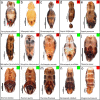Comparative analysis reveals the complex role of histoblast nest size in the evolution of novel insect abdominal appendages in Sepsidae (Diptera)
- PMID: 30314458
- PMCID: PMC6186081
- DOI: 10.1186/s12862-018-1265-3
Comparative analysis reveals the complex role of histoblast nest size in the evolution of novel insect abdominal appendages in Sepsidae (Diptera)
Abstract
Background: The males of some sepsid species (Sepsidae: Diptera) have abdominal appendages that are remarkable in several ways. They are sexually dimorphic, have a complex evolutionary history of gain and loss, and can be jointed and thus highly mobile. The sternite brushes are used extensively in complex courtship behaviors that differ considerably between species and during mating. The abdominal appendages have a novel developmental pathway developing from histoblast nests rather than imaginal discs.
Results: We focus on the evolution of cell number, nest area, and segment length in both sexes to understand how this tissue relates to the formation of novel abdominal appendages. We map histoblast nest size of wandering-phase larvae of 17 species across 10 genera to a phylogenetic tree of Sepsidae and demonstrate that abdominal appendages require significant increases of histoblast nest size and cell number in most species while one species produces small appendages even without such modifications. In species with particularly large appendages, not only the nests on the fourth, but nests in neighboring segments are enlarged (Themira biloba, Themira putris). The loss of abdominal appendages corresponds to the loss of an enlarged fourth histoblast nest, although one species showed an exception to this pattern. One species that constitutes an independent origin of abdominal appendages (Perochaeta dikowi) uses an unusual developmental mechanism in that the histoblast nest sizes are not sexually dimorphic.
Conclusions: The surprisingly high diversity in histoblast size and degree of sexual dimorphism suggests that the developmental mechanism used for abdominal appendage formation in sepsids is highly adaptable. The presence of appendages usually correlate with increased histoblast cell number and in most cases appendage loss results in a return to ancestral histoblast morphology. However, we also identify several exceptions that indicate the abdominal appendages have a malleable developmental origin that is responsive to selection.
Keywords: Comparative morphology; Evolutionary history; Histoblast; Novelty; Sepsidae.
Conflict of interest statement
Ethics approval and consent to participate
Not applicable.
Consent for publication
Not applicable.
Competing interests
The authors declare that they have no competing interests.
Publisher’s Note
Springer Nature remains neutral with regard to jurisdictional claims in published maps and institutional affiliations.
Figures








Similar articles
-
Evolution of novel abdominal appendages in a sepsid fly from histoblasts, not imaginal discs.Evol Dev. 2007 Jul-Aug;9(4):347-54. doi: 10.1111/j.1525-142X.2007.00171.x. Evol Dev. 2007. PMID: 17651359
-
Deciphering the evolutionary history and developmental mechanisms of a complex sexual ornament: the abdominal appendages of Sepsidae (Diptera).Evolution. 2013 Apr;67(4):1069-80. doi: 10.1111/evo.12006. Epub 2012 Dec 20. Evolution. 2013. PMID: 23550756
-
Selection on bristle length has the ability to drive the evolution of male abdominal appendages in the sepsid fly Themira biloba.J Evol Biol. 2015 Dec;28(12):2308-17. doi: 10.1111/jeb.12755. Epub 2015 Oct 5. J Evol Biol. 2015. PMID: 26356143
-
Patterning mechanisms and morphological diversity of spider appendages and their importance for spider evolution.Arthropod Struct Dev. 2010 Nov;39(6):453-67. doi: 10.1016/j.asd.2010.07.007. Arthropod Struct Dev. 2010. PMID: 20696272 Review.
-
Specification and Patterning of Drosophila Appendages.J Dev Biol. 2018 Jul 14;6(3):17. doi: 10.3390/jdb6030017. J Dev Biol. 2018. PMID: 30011921 Free PMC article. Review.
Cited by
-
Size rather than complexity of sexual ornaments prolongs male metamorphosis and explains sexual size dimorphism in sepsid flies.Proc Biol Sci. 2023 May 10;290(1998):20222531. doi: 10.1098/rspb.2022.2531. Epub 2023 May 3. Proc Biol Sci. 2023. PMID: 37132233 Free PMC article.
References
Publication types
MeSH terms
Grants and funding
LinkOut - more resources
Full Text Sources

